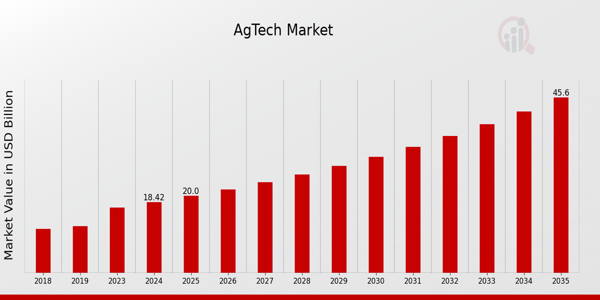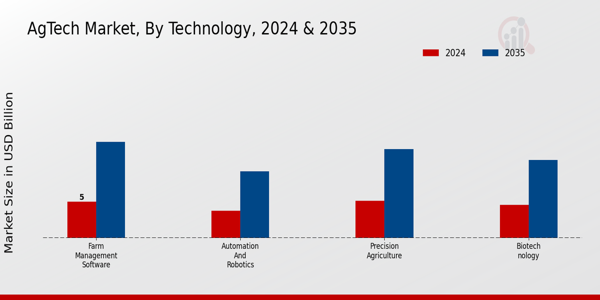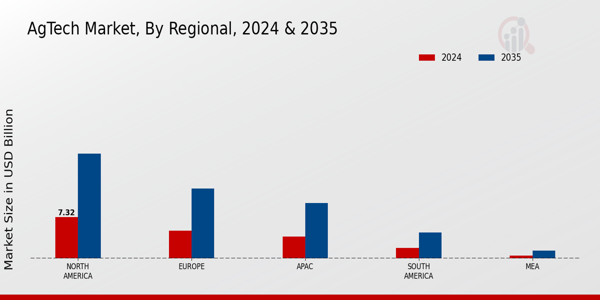Global AgTech Market Overview
AgTech Market Size was estimated at 16.96 (USD Billion) in 2023. The AgTech Market Industry is expected to grow from 18.42 (USD Billion) in 2024 to 45.6 (USD Billion) by 2035. The AgTech Market CAGR (growth rate) is expected to be around 8.59% during the forecast period (2025 - 2035).

Source Primary Research, Secondary Research, MRFR Database and Analyst Review
Key AgTech Market Trends Highlighted
The AgTech Market is witnessing significant market trends driven by increasing food demand due to a growing population and the need for sustainable agricultural practices. Precision agriculture is gaining traction, with farmers adopting technology to optimize crop yields and resource use. This trend is further enhanced by advancements in drone technology and satellite imaging, which offer real-time data to improve farming efficiency. The rise of urban farming initiatives and vertical farming also reflects changing consumer preferences towards locally sourced food and reduces transportation emissions. Key market drivers include the need for enhanced productivity, driven by challenges such as climate change, soil degradation, and water scarcity.
Different governments around the world are adopting policies and incentives to advance innovations in agriculture due to their significance in food security and economic growth. There is increasing concern regarding the use of chemicals and greater acceptance of bio pesticides and bio fertilizers as safer alternatives which is compliant with environmental policies and consumers preferring organic food. The AgTech Market offers opportunities in sectors such as the incorporation of artificial intelligence and machine learning in farming. These technologies have the ability to process large data sets to anticipate yield production or identify diseases in primary stages, thus lowering damages.
The increasing connectivity of rural areas through the expansion of high-speed internet is also facilitating the adoption of smart farming technologies, opening up new avenues for innovation and collaboration among growers. Overall, these trends point towards a more technologically advanced, sustainable, and efficient agricultural landscape on a scale.
AgTech Market Drivers
Increasing Population and Food Demand
As the population continues to rise, the demand for food is surging. Projections suggest that the world population will reach approximately 9.7 billion by 2050, according to the United Nations. This increase creates significant pressure on agricultural production, necessitating advanced agricultural technologies to enhance yields. For instance, the Food and Agriculture Organization has reported that agricultural production must increase by about 70 percent to feed the expected population.
Established organizations like Bayer and DuPont are investing heavily in the development of innovative agricultural solutions, such as precision farming technologies and genetically modified crops, to meet these increasing demands. The AgTech Market Industry stands to benefit immensely from this trend as farmers look to these advanced technologies to optimize their operations, reduce waste, and secure food supply chains in the face of rising challenges.
Advancements in Agricultural Technology
Rapid advancements in technology, including artificial intelligence, big data analytics, and the Internet of Things, are driving the AgTech Market Industry forward. The integration of these technologies into farming practices is enabling farmers to make data-driven decisions that enhance productivity and efficiency. For example, according to a report from the United States Department of Agriculture, precision agriculture techniques can improve productivity by upwards of 15 to 20 percent.
Companies like John Deere and Trimble are at the forefront of these advancements, offering systems that leverage sensors and satellite imagery to monitor crop health and soil conditions. This technological surge is expected to shape the future of farming by allowing precision targeting of resources, ultimately increasing the market's growth potential.
Sustainability Initiatives and Regulatory Support
The increasing emphasis on sustainable farming practices is significantly impacting the AgTech Market Industry. Governments and regulatory bodies worldwide are introducing policies aimed at promoting environmentally sustainable agriculture practices. For instance, the European Union's Green Deal aims to make food systems fair, healthy, and environmentally friendly by ensuring that 25 percent of agricultural land is organic by 2030. This push for sustainability is encouraging the adoption of technologies that minimize chemical use and conserve resources.
Companies such as Syngenta are leading the charge by developing eco-friendly crop protection solutions that comply with these regulations while ensuring agricultural efficiency. This regulatory push for sustainability is likely to bolster market growth by fostering innovation in greener technologies.
Rising Investments and Funding in AgTech Startups
There has been a notable increase in investments directed towards AgTech startups, highlighting the growing interest in innovative agricultural solutions. According to recent data, investment in AgTech startups reached approximately 4 billion dollars globally in 2021, demonstrating a year-on-year growth of 30 percent. This surge in funding is driven by interest from venture capital firms and established agricultural corporations pursuing innovations that solve pressing farming challenges.
Companies such as AgFunder and The Climate Corporation have been pivotal in fostering this ecosystem by providing much-needed capital and resources to startups focusing on technologies like vertical farming and automated crop management systems. The influx of investment not only brings innovative ideas to the market but also enhances the overall landscape of the AgTech Market Industry, paving the way for substantial growth.
AgTech Market Segment Insights
AgTech Market Technology Insights
The AgTech Market, focusing on the Technology segment, has demonstrated a robust trajectory, with expectations of significant growth over the next decade. In 2024, the overall market reached a valuation of 18.42 USD Billion, evidencing a strong foundation for future expansion, as the market aims for an estimated value of 45.6 USD Billion by 2035. This growth is underpinned by an expected compound annual growth rate of 8.59 from 2025 to 2035. Within this segment, Precision Agriculture stands out prominently, with a current valuation of 5.12 USD Billion in 2024, projected to rise to 12.3 USD Billion by 2035.
This sub-segment plays a significant role in enhancing crop yields, reducing resources, and increasing overall farm efficiency, thus exhibiting majority holding in market dynamics. Biotechnology was valued at 4.56 USD Billion in 2024 and is projected to grow to 10.78 USD Billion by 2035; it contributes significantly through innovations like genetically modified organisms and plant breeding techniques, addressing food security challenges effectively. Automation and Robotics, while slightly smaller at 3.74 USD Billion in 2024 and expected to reach 9.2 USD Billion in 2035, are becoming critical as labor shortages influence agricultural practices worldwide; they optimize operations and improve productivity.
Farm Management Software held a noteworthy position with a value of 5.0 USD Billion in 2024, expected to rise to 13.28 USD Billion by 2035, as it provides data-driven insights for better decision-making, resource allocation, and operational efficiency. The AgTech Market statistics reveal that these technological advancements not only drive efficiency and productivity gains but also address key challenges such as resource constraints and sustainability in the agricultural industry. The convergence of these technologies reflects a paradigm shift in how agriculture is approached globally, making this segment vital for addressing future demands while highlighting opportunities for stakeholders to optimize agricultural practices.

Source Primary Research, Secondary Research, MRFR Database and Analyst Review
AgTech Market Application Insights
The AgTech Market revenue reached 18.42 USD Billion in 2024, signaling robust growth within the Application segment. This segment encompasses key areas such as Crop Management, Soil Management, Livestock Management, and Greenhouse Management, each playing a pivotal role in enhancing agricultural productivity and sustainability. For instance, Crop Management solutions enable farmers to utilize advanced data analytics and precision farming techniques, thereby increasing yield efficiency and resource optimization. Soil Management technologies focus on monitoring soil health, which is crucial for improving crop quality, while Livestock Management applications streamline tracking and health monitoring of animals, ensuring better livestock practices.
Greenhouse Management innovations offer climate control and resource efficiency, aiding in year-round crop production. The AgTech Market segmentation highlights a growing awareness of sustainable agricultural practices driven by environmental concerns and the need for food security, with these applications becoming integral to meeting future food demands. As stakeholders embrace these advancements, the market growth is expected to continue, contributing significantly to the overall AgTech landscape by leveraging technology for enhanced agricultural outcomes.
AgTech Market End Use Insights
The AgTech Market is rapidly evolving, with a valuation of 18.42 USD Billion in 2024 and anticipated growth to 45.6 USD Billion by 2035, reflecting the increasing importance of technology in agriculture. A significant aspect of this market is its End Use, which includes various stakeholders such as Farms, Agricultural Cooperatives, and Research Institutions. The majority of market activities revolve around Farms, where innovative technologies enhance productivity and sustainability through precision agriculture and data analytics.
Agricultural Cooperatives play a crucial role as they enable collective buying and resource sharing among farmers, thus improving market access and reducing costs. Research Institutions contribute significantly to the AgTech Market, focusing on innovation and development of new agricultural solutions, thereby maintaining the industry's competitive edge. Various trends, such as the rising demand for sustainable practices, efficiency in resource utilization, and advancements in biotechnology, drive the market growth. However, challenges like regulatory compliance and the need for comprehensive training on new technologies remain.
Overall, the AgTech Market segmentation highlights the diverse roles and contributions of these entities, reflecting their importance in addressing food security and agricultural productivity.
AgTech Market Farm Size Insights
The AgTech Market is experiencing significant growth in the Farm Size segment, with a market valuation that reached 18.42 billion USD by 2024, reinforcing its importance in the agricultural landscape. This segment is essential as it encompasses farms of varying sizes, each with distinct needs and technological adoption rates. Small Scale farms often rely on innovative solutions to enhance productivity and sustainability, while Medium Scale farms typically integrate AgTech offerings to optimize resource management and yield. Large Scale farms, representing a major portion of the market, utilize advanced technologies for precision agriculture, ensuring efficiency and maximizing output.
The increasing demand for sustainable farming practices and the push towards automation drive growth in this segment. Furthermore, government investments in agricultural technology and initiatives aimed at increasing food security globally enhance the opportunities available within the AgTech Market. Overall, the market statistics indicate a diverse and dynamic landscape where innovation is key to addressing the varying challenges faced by different farm sizes.
AgTech Market Regional Insights
The AgTech Market revenue demonstrated substantial variation across different regions, with North America leading the way with a valuation of 7.32 USD Billion in 2024, projected to reach 18.5 USD Billion by 2035. This dominance is attributed to advanced agricultural practices and significant investments in technology. Europe followed with a valuation of 4.92 USD Billion in 2024, driven by a strong emphasis on sustainability and innovation within agriculture, aiming for 12.3 USD Billion by 2035. The Asia-Pacific (APAC) region was valued at 3.84 USD Billion in 2024 and is expected to grow to 9.8 USD Billion, supported by increasing population and demand for food security.
South America, with a valuation of 1.84 USD Billion, and the Middle East and Africa (MEA), valued at 0.5 USD Billion, highlighted emerging markets that are gradually gaining traction, reaching 4.6 USD Billion and 1.4 USD Billion, respectively, by 2035. These market statistics indicate varying levels of development and investment opportunities, emphasizing significant growth potential across all regions yet showcasing North America and Europe as pivotal players in the ongoing evolution of the AgTech Market industry.

Source Primary Research, Secondary Research, MRFR Database and Analyst Review
AgTech Market Key Players and Competitive Insights
The AgTech Market is characterized by a dynamic landscape shaped by the intersection of technology and agriculture. With an increasing emphasis on sustainable practices, innovation in crop management, and advancements in data analytics, companies within this sector are leveraging cutting-edge solutions to enhance productivity and efficiency. The competition is primarily driven by the need for agricultural automation, precision farming, soil health improvement, and resource optimization. As stakeholders recognize the urgent need to improve food security while minimizing environmental impact, the demand for AgTech solutions continues to grow. Companies are employing various strategies such as strategic partnerships, technological collaborations, and extensive research and development efforts to gain a competitive edge in this advancing market.
Phytelligence has established a significant presence in the AgTech Market by focusing on providing innovative plant-based solutions that enhance agricultural productivity. Their unique strengths stem from a deep understanding of plant physiology combined with proprietary technologies that enable improved plant quality and growth rates. Phytelligence is known for its data-driven approach, utilizing advanced analytics to optimize the development of various crops, which supports better yield outcomes for farmers. This focus on research and quality has positioned Phytelligence as a reliable partner for growers seeking optimized growth solutions, ultimately contributing to a more sustainable agricultural framework.
Trimble, on the other hand, holds a prominent position in the AgTech Market, known for providing comprehensive solutions that integrate hardware, software, and services aimed at improving operational efficiency in agriculture. Trimble's key products include precision agriculture tools, such as GPS systems, data management platforms, and irrigation solutions, which enable farmers to make informed decisions based on real-time data. The company's strengths are enhanced by its commitment to innovation and customer-centric solutions, fostering key partnerships to expand its market reach. Trimble actively engages in mergers and acquisitions to bolster its technological capabilities and broaden its service offerings, ensuring a robust market presence. This approach allows Trimble to address various challenges faced by growers globally, solidifying their reputation as a leader in precision agriculture technologies.
Key Companies in the AgTech Market Include
- Phytelligence
- Trimble
- Aphria
- Tractor Supply Company
- Nutrien
- AG Leader Technology
- John Deere
- Monsanto
- Syngenta
- Corteva
- Yara
- BASF
- Bayer
- Trelleborg
- FMC
AgTech Market Industry Developments
Recent developments in the AgTech Market highlight a notable increase in investment and technology adoption, driven by a growing population and the need for sustainable agriculture. Companies like Nutrien and John Deere are leading efforts to integrate artificial intelligence and data analytics to enhance crop yield and resource efficiency. In October 2023, Bayer announced its plans to expand its Crop Science division, aiming to boost its presence in precision agriculture, while Syngenta introduced innovative seed varieties aimed at climate resilience. Notably, in July 2023, Corteva Agriscience completed its acquisition of a biotech firm, enhancing its capabilities in seed technology. Furthermore, in the past two years, BASF has increased its investment in biopesticides, reflecting a shift towards more environmentally friendly agricultural practices. The valuation of companies such as Tractor Supply Company has surged due to the growing demand for agricultural supplies and home gardening products, showcasing the market's resilience amid economic challenges. Additionally, the implementation of sustainable practices is gaining momentum in the AgTech sector, as indicated by Yara's recent initiatives to promote nitrogen efficiency and reduce greenhouse gas emissions in farming.
AgTech Market Segmentation Insights
AgTech Market Technology Outlook
- Precision Agriculture
- Biotechnology
- Automation and Robotics
- Farm Management Software
AgTech Market Application Outlook
- Crop Management
- Soil Management
- Livestock Management
- Greenhouse Management
AgTech Market End Use Outlook
- Farms
- Agricultural Cooperatives
- Research Institutions
AgTech Market Farm Size Outlook
- Small Scale
- Medium Scale
- Large Scale
AgTech Market Regional Outlook
-
North America
-
Europe
-
South America
-
Asia Pacific
-
Middle East and Africa
|
Report Attribute/Metric
|
Details
|
|
Market Size 2023
|
16.96 (USD Billion)
|
|
Market Size 2024
|
18.42 (USD Billion)
|
|
Market Size 2035
|
45.6 (USD Billion)
|
|
Compound Annual Growth Rate (CAGR)
|
8.59% (2025 - 2035)
|
|
Report Coverage
|
Revenue Forecast, Competitive Landscape, Growth Factors, and Trends
|
|
Base Year
|
2024
|
|
Market Forecast Period
|
2025 - 2035
|
|
Historical Data
|
2019 - 2024
|
|
Market Forecast Units
|
USD Billion
|
|
Key Companies Profiled
|
Phytelligence, Trimble, Aphria, Tractor Supply Company, Nutrien, AG Leader Technology, John Deere, Monsanto, Syngenta, Corteva, Yara, BASF, Bayer, Trelleborg, FMC
|
|
Segments Covered
|
Technology, Application, End Use, Farm Size, Regional
|
|
Key Market Opportunities
|
Precision agriculture technology adoption, Sustainable farming practices increase, Vertical farming growth potential, Agri-data analytics expansion, Biopesticides and biofertilizers rise
|
|
Key Market Dynamics
|
Technological advancement, Sustainability focus, Crop yield improvement, Data-driven decision-making, Investment growth
|
|
Countries Covered
|
North America, Europe, APAC, South America, MEA
|
Frequently Asked Questions (FAQ) :
The AgTech Market is expected to be valued at 18.42 USD Billion in 2024.
By 2035, the AgTech Market is projected to reach a value of 45.6 USD Billion.
The expected CAGR for the AgTech Market from 2025 to 2035 is 8.59%.
North America is expected to dominate the AgTech Market, projected at 18.5 USD Billion by 2035.
The European AgTech Market is anticipated to be valued at 12.3 USD Billion in 2035.
The market size for Precision Agriculture is valued at 5.12 USD Billion in 2024.
The market value for Automation and Robotics is expected to reach 9.2 USD Billion by 2035.
Key players in the AgTech Market include John Deere, Bayer, Corteva, and Nutrien.
The Biotechnology segment is expected to be valued at 4.56 USD Billion in 2024.
The AgTech Market is expected to experience robust growth driven by technological advancements and increasing demand for food production.

















